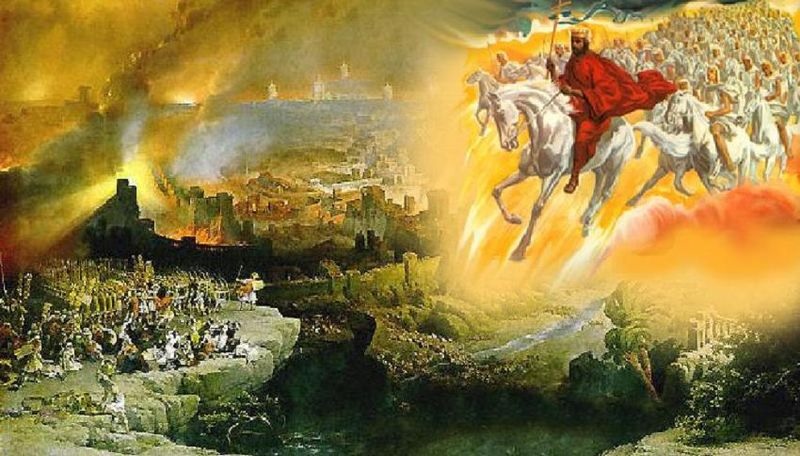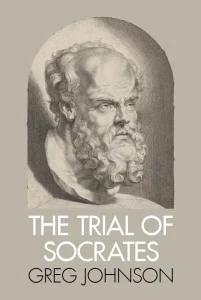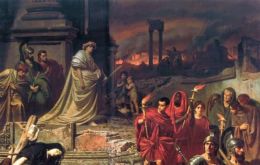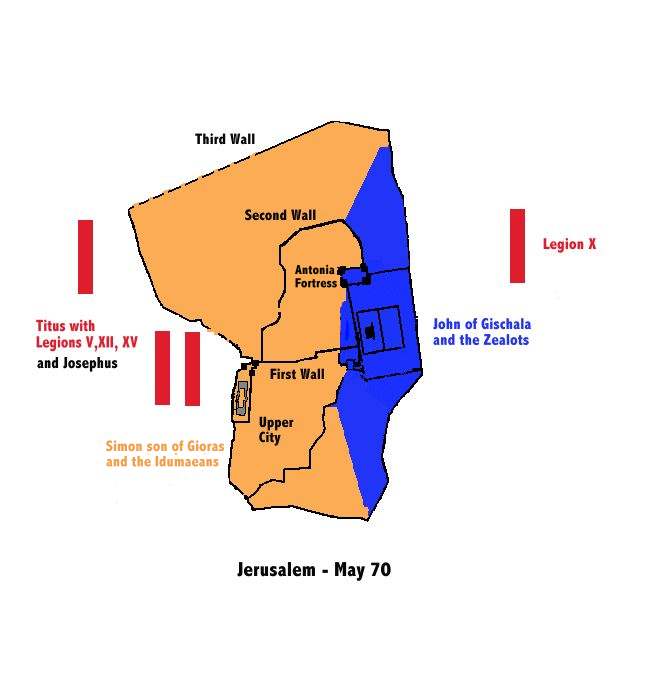Can Preterism Put an End to Christian Zionism? Part 2
Posted By Morris van de Camp On In North American New Right | Comments Disabled2,164 words
Part 2 of 3 (Part 1 here [2], Part 2 here [3])
The Roman-Jewish War
Nero squeezed the economy of the entire empire to rebuild Rome after the fire. One of his schemes to acquire money was to tax the treasuries of religious institutions. He also appointed a crony, Gessius Florus, as Governor of Judea in 64. Florus is said to have favored the Greeks in Judea over the Jews, but he is probably unjustly maligned by history. It is likely that he was merely attempting to treat Jews and non-Jews equally.
Flavius Josephus, who lived in the region during this time, documents the start of the war in Roman Judea in his The Wars of the Jews [4]:
Now the occasion of this war was by no means proportionable to those heavy calamities which it brought upon us. For the Jews that dwelt at Cesarea had a synagogue near the place, whose owner was a certain Cesarean Greek: the Jews had endeavored frequently to have purchased the possession of the place, and had offered many times its value for its price; but as the owner overlooked their offers, so did he raise other buildings upon the place, in way of affront to them, and made working-shops of them, and left them but a narrow passage, and such as was very troublesome for them to go along to their synagogue. Whereupon the warmer part of the Jewish youth went hastily to the workmen, and forbade them to build there; but as Florus would not permit them to use force, the great men of the Jews, with John the publican, being in the utmost distress what to do, persuaded Florus, with the offer of eight talents, to hinder the work. He then, being intent upon nothing but getting money, promised he would do for them all they desired of him, and then went away from Cesarea to Sebaste, and left the sedition to take its full course, as if he had sold a license to the Jews to fight it out.
Now on the next day, which was the seventh day of the week, when the Jews were crowding apace to their synagogue, a certain man of Cesarea, of a seditious temper, got an earthen vessel, and set it with the bottom upward, at the entrance of that synagogue, and sacrificed birds. This thing provoked the Jews to an incurable degree, because their laws were affronted, and the place was polluted. Whereupon the sober and moderate part of the Jews thought it proper to have recourse to their governors again, while the seditious part, and such as were in the fervor of their youth, were vehemently inflamed to fight.
While rioting was going on in Caesarea in 66, Florus went to Jerusalem to take 17 talents of silver from the Temple’s treasury. He was probably acting upon Nero’s directives to obtain silver and gold from religious institutions in order to rebuild Rome. He was enraged by the resulting protests in Jerusalem. Flavius writes that instead of quelling the disorder, Florus “marched hastily with an army of horsemen and footmen against Jerusalem, that he might gain his will by the arms of the Romans, and might, by his terror, and by his threatenings, bring the city into subjection.”
 [5]
[5]Troop movements during the Roman-Jewish War. It took 42 months for the Roman army to subdue the countryside around Jerusalem and then move in for the final siege.
The Siege of Jerusalem
 [6]
[6]You can buy Tito Perdue’s novel Opportunities in Alabama Agriculture here [7].
Flavius Josephus’ account of the war is gripping and has a Lord of the Rings [8] feel from beginning to end. At the outset of the conflict, the Jews had the advantage. They also expected Jews from Babylon, Persia, and other areas to support them. The Romans were then led by an unpopular Emperor who had alienated the Roman political elite to such a degree that a coup of some form was bound to happen. The Jews, however, did not recognize the enormous hostility that their Gentile neighbors had for them, and thus did not realize that the disorder in Rome was not to their favor.
Nero died by suicide in 68, and thus Rome’s subjugation of the Jews was delayed by the following political disorder during the “Year of the Four Emperors” in 69 A.D. Vespasian, who was the commander of the Roman forces in Judea, ended up as the Emperor that summer and restored order. His son Titus, who was already with the army in Judea, was left in command to sort out matters with the Jews. During the Passover Festival of 70, the Romans surrounded Jerusalem [9] while the city was filled with Jewish pilgrims. It took the Romans three and a half years, or 42 months, to get their forces to Jerusalem for the final battle.
Although the Roman army was as good as any that has ever been raised under the Sun, and even though the Jews in Jerusalem were divided, it still took five months to reduce the city. Jerusalem is built on easily-defendable terrain, and it consists of a series of walled fortresses. The defenders were also highly motivated to resist.
Titus was nearly killed while conducting a reconnaissance of the city shortly after his forces arrived at Jerusalem. Flavius Josephus writes:
. . . [A]n immense number of the Jews leaped out suddenly at the towers called the “Women’s Towers,” through that gate which was over against the monuments of queen Helena, and intercepted his horse; and standing directly opposite to those that still ran along the road, hindered them from joining those that had declined out of it. They intercepted Titus also, with a few other. Now it was here impossible for him to go forward, because all the places had trenches dug in them from the wall, to preserve the gardens round about, and were full of gardens obliquely situated, and of many hedges; and to return back to his own men, he saw it was also impossible, by reason of the multitude of the enemies that lay between them; many of whom did not so much as know that the king was in any danger, but supposed him still among them. So he perceived that his preservation must be wholly owing to his own courage, and turned his horse about, and cried out aloud to those that were about him to follow him, and ran with violence into the midst of his enemies, in order to force his way through them to his own men.
 [11]
[11]Titus was nearly killed in an ambush while conducting a reconnaissance of Jerusalem. Although not wearing armor, he was able to cut his way back to the Roman lines.
The Romans took the city after they’d built fortified camps, built an additional wall around it to keep infiltrators in and food out, and then brought up siege towers to batter down the walls. Conditions in the city were dreadful. The Romans first breached the wall on the city’s northwestern side, and then took the rest of the city one walled enclosure at a time. The Second Temple was not destroyed at the end of the siege, but was destroyed midway through it.
After Jerusalem was finally subdued,
Caesar gave orders that [the Roman army] should now demolish the entire city and temple, but should leave as many of the towers standing as were of the greatest eminency; that is, Phasaelus, and Hippicus, and Mariamne; and so much of the wall as enclosed the city on the west side. This wall was spared, in order to afford a camp for such as were to lie in garrison, as were the towers also spared, in order to demonstrate to posterity what kind of city it was, and how well fortified, which the Roman valor had subdued; but for all the rest of the wall, it was so thoroughly laid even with the ground by those that dug it up to the foundation, that there was left nothing to make those that came thither believe it had ever been inhabited. This was the end which Jerusalem came to by the madness of those that were for innovations; a city otherwise of great magnificence, and of mighty fame among all mankind.
Full Preterists point to Josephus to show that Christ returned during the Siege of Jerusalem in 70. Josephus writes of several signs that could be interpreted as the Second Coming. A heifer brought forth a lamb as it was about to be sacrificed in the Temple, a mysterious light shone on the Temple, and a comet appeared, as did a star that looked like a sword. Josephus then writes:
. . . on the one and twentieth day of the month Artemisius, [Jyar,] a certain prodigious and incredible phenomenon appeared: I suppose the account of it would seem to be a fable, were it not related by those that saw it, and were not the events that followed it of so considerable a nature as to deserve such signals; for, before sun-setting, chariots and troops of soldiers in their armor were seen running about among the clouds, and surrounding of cities.
 [12]
[12]Full Preterism argues that the Second Coming of Jesus Christ occurred in 70 AD, during the siege of Jerusalem.
The prophecy of the destruction of Jerusalem in the New Testament
 [13]
[13]You can buy Greg Johnson’s The Trial of Socrates here [14].
The writings of Flavius Josephus are not holy scripture, however. Full Preterists point out that the vision described by Josephus matches Jesus’ prophetic words in Matthew 26:64 (KJV [15]): “. . . ye see the Son of man sitting on the right hand of power, and coming in the clouds of heaven.” There is also Revelation 1:7 (KJV [16]): “Behold, he cometh with clouds; and every eye shall see him, and they also which pierced him: and all kindreds of the earth shall wail because of him. Even so, Amen.” These passages rely heavily on the supernatural. Although there is far more in the Bible that makes the Full Preterist case.
The New Testament comprises the gospels of Matthew, Mark, Luke, and John. The first three gospels are called the Synoptic Gospels. They tell similar stories in roughly the same order. John’s gospel is called the spiritual gospel. In addition to proclaiming the message of Christ, John’s gospel separates Christianity from Judaism and also incorporates Greek philosophy in its first chapter:
In the beginning was the Word (λόγος), and the Word (λόγος) was with God, and the Word (λόγος) was God. (John 1:1 KJV [17])
The Word, or logos (λόγος), was a well-known Greek philosophical concept meaning “reason [18].”
The Book of Acts, which is the sequel to Luke’s Gospel, follows John. Then there are a series of letters, most of which were written by the Apostle Paul. These letters clarify Christian doctrine and resolve the theological and philosophical disputes which had arisen in the various churches of the early Christians. After the letter of Jude, which encourages steadfastness and avoiding sexually reckless behavior, there is the Book of Revelation, which prophesies the Second Coming of Christ.
The Olivet Discourse
The Olivet Discourse is found in the Synoptic Gospels. There, Christ predicts the coming persecution of the Christians, as well as the destruction of the Temple, in Matthew 24 [19], Mark 13 [20], and Luke 19 [21], 21 [22], and 23 [23].
As for the temple, Christ says, “There shall not be left one stone upon another, that shall not be thrown down.” Jesus adds that there will be a series of false messiahs, and that “ye shall hear of wars and rumors of wars,” “nation shall rise against nation, and kingdom against kingdom,” and that there will be earthquakes. Christians will also be persecuted, and some will become discouraged and fall away.
Luke is the most descriptive of the Synoptic Gospels, and it recounts an important prophetic episode. When Jesus is being led away through Jerusalem to be crucified, he says to several weeping women:
Daughters of Jerusalem, do not weep for me; weep for yourselves and for your children. For the time will come when you will say, “Blessed are the childless women, the wombs that never bore and the breasts that never nursed!” Then they will say to the mountains, “Fall on us! and to the hills, Cover us!” (Luke 23:28 KJV [24])
Even as he was being led away, Christ warned the people of Jerusalem that they were on a path that would lead to starvation and destruction. During the Siege of Jerusalem, conditions were abysmal. Women with no children came to see their barrenness as a blessing.
 [25]
[25]Full Preterists believe that Jesus predicted the destruction of Jerusalem as he was being taken away to be crucified.
Even from a secular perspective, it is not difficult to believe that Jesus Christ would have been able to make such a prophecy. The Mormon Prophet Joseph Smith, Jr. predicted [26] the US Civil War [27] in 1832. Even if one doesn’t believe in Christ or Joseph Smith, it is clear that both were spiritual geniuses, and such geniuses often correctly predict the direction in which society is heading before anyone else.

